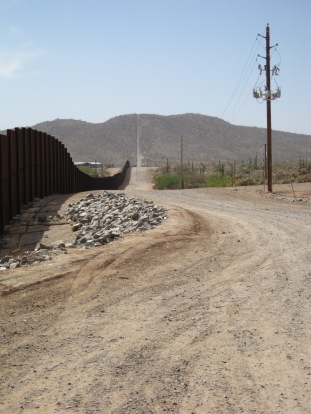by Sam Schieffelin
 A defining characteristic of nation-building is often the construction of a physical barrier demarcating a political boundary between two nations. The fences which stretch along the border separating Mexico from the United States are the embodiment of this idea of making a state real, or territorialization. The fence itself is not continuous along the border; some areas have little more than barbed wire to separate the two countries. Other areas have vehicle barriers, which are simple posts cemented vertically into the ground and bound together with railroad ties.[1] This type of fence, completed in 2006, exists along about twenty miles of the U.S.-Mexico border inside Organ Pipe Cactus National Monument. The most recognizable type of border fence is the “pedestrian barrier,” a double-layered fifteen-foot-high wall of metal designed to keep people from illegally crossing the border on foot. This type of fence can also be seen in the monument.[2]
A defining characteristic of nation-building is often the construction of a physical barrier demarcating a political boundary between two nations. The fences which stretch along the border separating Mexico from the United States are the embodiment of this idea of making a state real, or territorialization. The fence itself is not continuous along the border; some areas have little more than barbed wire to separate the two countries. Other areas have vehicle barriers, which are simple posts cemented vertically into the ground and bound together with railroad ties.[1] This type of fence, completed in 2006, exists along about twenty miles of the U.S.-Mexico border inside Organ Pipe Cactus National Monument. The most recognizable type of border fence is the “pedestrian barrier,” a double-layered fifteen-foot-high wall of metal designed to keep people from illegally crossing the border on foot. This type of fence can also be seen in the monument.[2]
In 2006, the Secure Fence Act was passed by Congress calling for over seven hundred miles of new fence to be constructed along parts of the border in California, Texas, and Arizona, including Organ Pipe Cactus National Monument.[3] Sources disagree on the exact cost of the project, but all agree on a multi-billion dollar scope.[4] This project ignited local controversy on ranches and in towns near the proposed fence, as well as nationally among human rights groups and environmentalists who cited environmental regulations and laws that were ignored for the project.[5]
Natural borders between climate zones, habitats, or land cover types, have been shaping the land and its inhabitants long before any political boundary was invented.[6] Such is the concern among people who feel that the fence is harming the land and the creatures who call this region home. Species that once roamed freely in this area suddenly confronted an impenetrable barrier that cut their populations and habitats in half. Rainwater, so scarce yet sporadically delivered in great amounts, was suddenly unable to follow its usual drainage patterns despite planning by fence engineers.[7] These, in addition to aesthetic effects of this fence on Organ Pipe Cactus National Monument, can already be seen by the park rangers, staff, and visitors.
Further Reading
Associated Press. “Border Blunder: Security Fence Causes Flooding.” MSNBC, http://www.msnbc.msn.com/id/26396487/ns/us_news-environment/t/border-blunder-security-fence-causes-flooding/ (accessed February 1, 2012).
Associated Press, “Critics of Fence Point to Flood at Border Sites,” New York Times, August 26, 2008. under “U.S.” http://www.nytimes.com/2008/08/26/us/26fence.html (accessed January 29, 2012).
National Park Service. “Organ Pipe Cactus National Monument, Monument Timeline.” National Park Service. http://www.nps.gov/orpi/historyculture/monument-timeline.htm. (accessed January 29, 2012).
[1] Leo Banks, “Border Fence Benefits the Environment,” The Daily Caller, http://dailycaller.com/2010/10/04/border-fence-benefits-the-environment/ (accessed January 31, 2012).
[2] John Pomfret, “Fence Meets Wall of Skepticism; Critics Doubt a 700-mile Barrier Will Stem Migrant Tide,” Washington Post, October 10, 2006.
[3] Tom Leskiw, “A Region of Wounds Severing the U.S.-Mexico Borderlands,” Terrain 24 (Fall/Winter, 2009) http://www.terrain.org/articles/24/leskiw.htm (accessed February 1, 2012).
[4] John Pomfret, “Fence Meets Wall of Skepticism; Critics Doubt a 700-mile Barrier Will Stem Migrant Tide,” Washington Post, October 10, 2006.
[5] Joe Vickless, “Conservation Groups Ask Federal Government to Consider Border Fence’s Overall Impact to Wildlife Public Lands in Arizona,” Defenders of Wildlife, http://www.defenders.org/newsroom/press_releases_folder/2007/10_01_2007_groups_appeal_to_feds_on_border_fence.php (accessed January 29, 2012).
[6] Tom Leskiw, “A Region of Wounds Severing the U.S.-Mexico Borderlands,” Terrain 24 (Fall/Winter, 2009) http://www.terrain.org/articles/24/leskiw.htm (accessed February 1, 2012).
[7] Bethany Walder, “Immigration, Wildlife, and the Wall,” Wildlands CPR, December 4, 2008, http://www.wildlandscpr.org/article/immigration-wildlife-and-wall (Accessed January 30, 2012).
